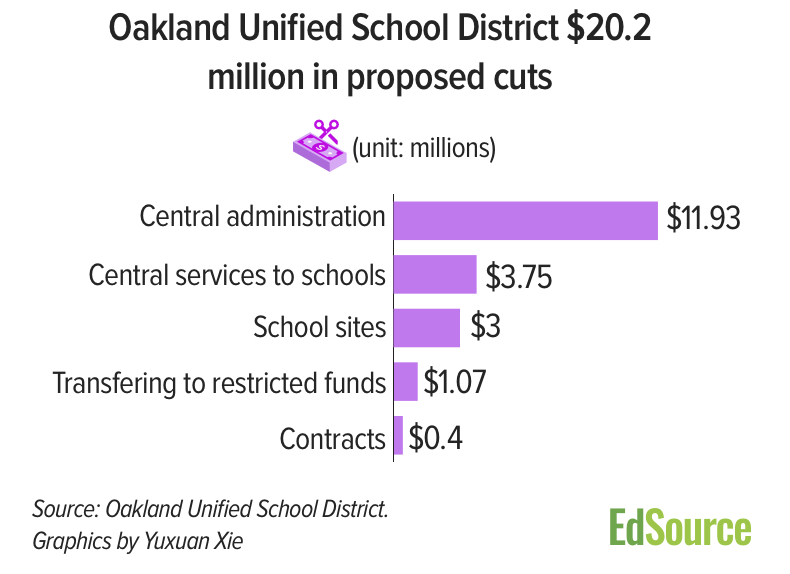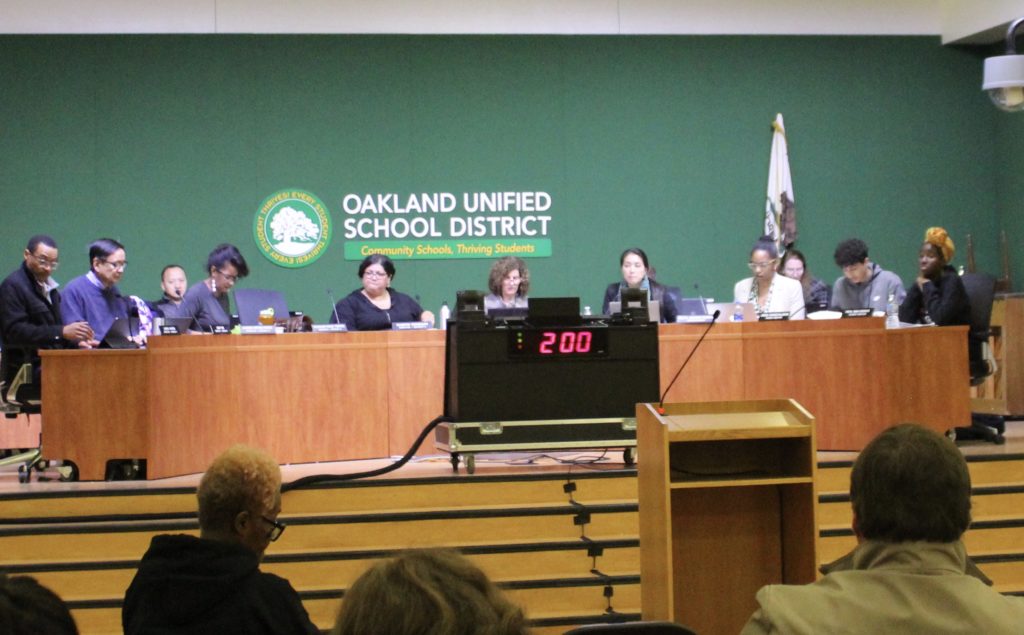
Black teachers: How to recruit them and make them stay

Lessons in higher education: What California can learn

Keeping California public university options open

Superintendents: Well-paid and walking away

The debt to degree connection

College in prison: How earning a degree can lead to a new life

For months, district officials in Oakland Unified have issued warnings that they need to cut $30 million from their budget to avoid deficit-spending and prevent another state takeover.
But when the school board was faced with making cuts on Monday, board President Aimee Eng said the vote would be delayed until later this month, to give the board and public more time to get more information about how the cuts — expected to include layoffs of more than 100 people — would affect students and schools.
The board will hold a meeting Feb. 19 to further discuss a proposal from Superintendent Kyla Johnson-Trammell to make $20.2 million in cuts to its $586 million budget for the 2019-20 school year. A vote is expected on Feb. 25.
Faced with a possible teachers’ strike as early as next week — and deep budget cuts that include closing or consolidating up to 24 schools over the next five years, along with cuts to successful programs and services — the district has taken on an aura of chaos, according to district critic Mike Hutchinson, who is helping to lead parent and community opposition to cuts and school closures.
“We’ve never seen anything like this,” he said. “We’re into ‘all bets are off’ kind of territory. There is no playbook for this. This is madness to me.”
Included in the cuts are programs such as restorative justice, foster youth case management and outreach to Southeast Asian and Pacific Islander students.
A coalition of advocacy groups including the Public Advocates civil rights law firm, expressed “deep frustration” with the budget process in a letter to the board, saying district administration “has not been transparent, inclusive or accountable to the board or community.”
With a neutral fact finders report on the teachers’ contract impasse expected on Friday, district spokesman John Sasaki said the district is “still trying to find a way to settle this labor dispute and avoid a strike.”
Teachers can legally strike anytime after the report is issued. Sasaki said the district hopes the report will “give us a springboard into some more discussions that will help us work all this out.”
The contract dispute is the reason district officials say they cannot be specific about how much of next year’s proposed cuts could be used to free up money for a settlement. Johnson-Trammell has laid out a plan for $20.2 million in cuts that could include more than 100 layoffs of central office staff, along with about $1.6 million in energy savings and new revenue from renting out district properties and opening buildings for Saturday make-up classes.
But missing from the report was a plan detailing how the central office would reorganize after the cuts to provide support to schools and students, along with a clear explanation of how much of the cuts were necessary to reduce the district’s deficit, how much was needed for teacher raises and how much was earmarked for increasing the district’s reserves, which could cover unexpected expenses.
Instead of recommending $30 million in cuts from the 2019-20 district budget as originally projected last summer, Johnson-Trammell said she recommended the lower amount in part because the district is in a “slightly better financial status.” A budget report the board expects to review on Wednesday shows the district operating in the black. That has raised questions in the community and the teachers’ union about how big the deficit really is.

When EdSource recently asked the district’s Chief Business Officer Marcus Battle how much of the reductions were necessary to cover the deficit and how much would be available for teacher raises and other new expenditures, he declined to say.
“The only reason I can’t answer that is because we’re in negotiations right now,” he said. “If we weren’t in negotiations, then we would just be trying to balance the budget. Because we’re trying to do both, it makes it so we can’t totally discuss what our position is.”
Dennis Nelson, a teacher on the union’s bargaining team, said the district’s budget numbers have kept changing since June, making it difficult to determine the size of the deficit.
“We have no idea, really,” he said.
Union officials are hopeful that the fact-finding report may shed light on how much money the district has available to meet teachers’ demands for a 12 percent raise over three years, reduced class sizes and increased student supports including counselors and nurses.
The district has so far offered a 5 percent raise over three years, along with class size reductions that the union has rejected as insufficient. These are included in the proposed budget cuts. But it’s unclear how much additional money could be made available for contract concessions.
Johnson-Trammell said she made her recommendations in part based on feedback from principals, students and community members. A student survey prioritized teacher quality, college and career support, student leadership programs and mental health and wellness programs. Students have spoken out against cuts to counselors, restorative justice and school closures.
Referring to a proposed cut of nearly $1.2 million to the district’s Police Department that would take away 24 school security officers and reassign them from elementary schools to various high schools, board member Roseann Torres predicted “we may have schools pitted against each other” over safety issues. She said she supported cutting police, but worried that the proposed cuts would cause “chaos and pandemonium.”
Board member James Harris said he was against Johnson-Trammell‘s proposal to cut up to $5 million earmarked for low-income students, foster youth, English learners and homeless students and redirecting it toward teacher raises. Johnson-Trammell said that reallocation would need to be approved by the district’s parent and student committee that oversees the district’s Local Control Accountability Plan.
Instead, Harris said he would prefer to reduce the district’s reserve funding, which is set aside to cover unanticipated expenses, from 3 percent to the state-mandated 2 percent. A 3 percent reserve totals about $15 million, while a 2 percent reserve would be about $10 million to $11 million, said Ofelia Roxas, the district’s chief financial officer.

Theresa Harrington/EdSource Today
The Oakland school board discusses proposed budget cuts on Feb. 11, 2018.
Board member Shanthi Gonzalez said the board wants to see “more of a vision” for how the central office will serve students differently. She and Eng objected to $3 million in across the board cuts to schools, saying those that have the ability to raise their own funds could backfill cuts more easily than those in low-income areas.
At the upcoming Feb. 19 meeting, Eng wants to discuss possible amendments to the plan, such as prioritizing any new money the district receives for school sites. Board member Gary Yee asked for a list of possible tradeoffs that could be made to preserve some of the proposed cuts.
Johnson-Trammell said that if the board rejects some of her proposed cuts, it would need to make different cuts to achieve the goals of increasing the reserve fund, eliminating the deficit and providing new money for teachers’ raises.
Part of the problem, said board member Jody London, is that the state does not adequately fund public education.
Harris said it’s important for the board and public to see how the proposed cuts would affect individual schools to prevent a “feeding frenzy” with schools competing against each other for resources. He said tradeoffs include making cuts to programs such as restorative justice to carve out money for teachers’ raises and building up reserve funds.
“The question for the community is: ‘Are you willing to make those tradeoffs?’” he said. “What are you willing to give up to retain the best and brightest here in Oakland? It’s not as though we can continue to do business as we are.”
Editor’s Note: As a special project, EdSource is tracking developments this year in the Oakland Unified and West Contra Costa Unified School Districts as a way to illustrate some of the most urgent challenges facing many urban districts in California. West Contra Costa Unified includes Richmond, El Cerrito and several other East Bay communities.

The overreliance on undersupported part-time faculty in the nation’s community colleges dates back to the 1970s during the era of neoliberal reform — the defunding of public education and the beginning of the corporatization of higher education in the United States. Decades of research show that the systemic overreliance on part-time faculty correlates closely with declining rates of student success. Furthermore, when faculty are… read more

Panelists discussed dual admission as a solution for easing the longstanding challenges in California’s transfer system.

A grassroots campaign recalled two members of the Orange Unified School District in an election that cost more than half a million dollars.

Legislation that would remove one of the last tests teachers are required to take to earn a credential in California passed the Senate Education Committee.
Comments (7)
Comments Policy
We welcome your comments. All comments are moderated for civility, relevance and other considerations. Click here for EdSource's Comments Policy.
Alejandra Maribel Matias Ramos 5 years ago5 years ago
Who can I contact at the school board to voice out my opinion on this issue? It can be through email or mail or calling?
Replies
Theresa Harrington 5 years ago5 years ago
Click on each school board directors’ name for his or her contact info: https://www.ousd.org/domain/3084
Suzy 5 years ago5 years ago
Marcus Battle is no longer part of OUSD. The CFO is back.
Replies
Theresa Harrington 5 years ago5 years ago
Yes, Battle’s position is being eliminated as part of the district’s reorganization process, according to the district, and his last day will be April 5. The CFO role will remain intact.
Bart 5 years ago5 years ago
It’s a bummer that education is getting cut so much.
bitty 5 years ago5 years ago
Years of hemming and hawing continue in OUSD. It sounds like the board members have not yet learned the schools with the possibility of outside funds have district funds allotted pennies to the dollar compared to schools who do not have outside funds. So pulling money from those schools and not the rest will end up with pennies saved. You would think they would have noticed that somewhere along the way.
Bill Conrad 5 years ago5 years ago
There may be a silver lining in the budget cuts as it will force OUSD to refocus on what matters most and what was identified by the students: Teacher quality! Time to work on improving and aligning professional practices, curricula, and assessments.